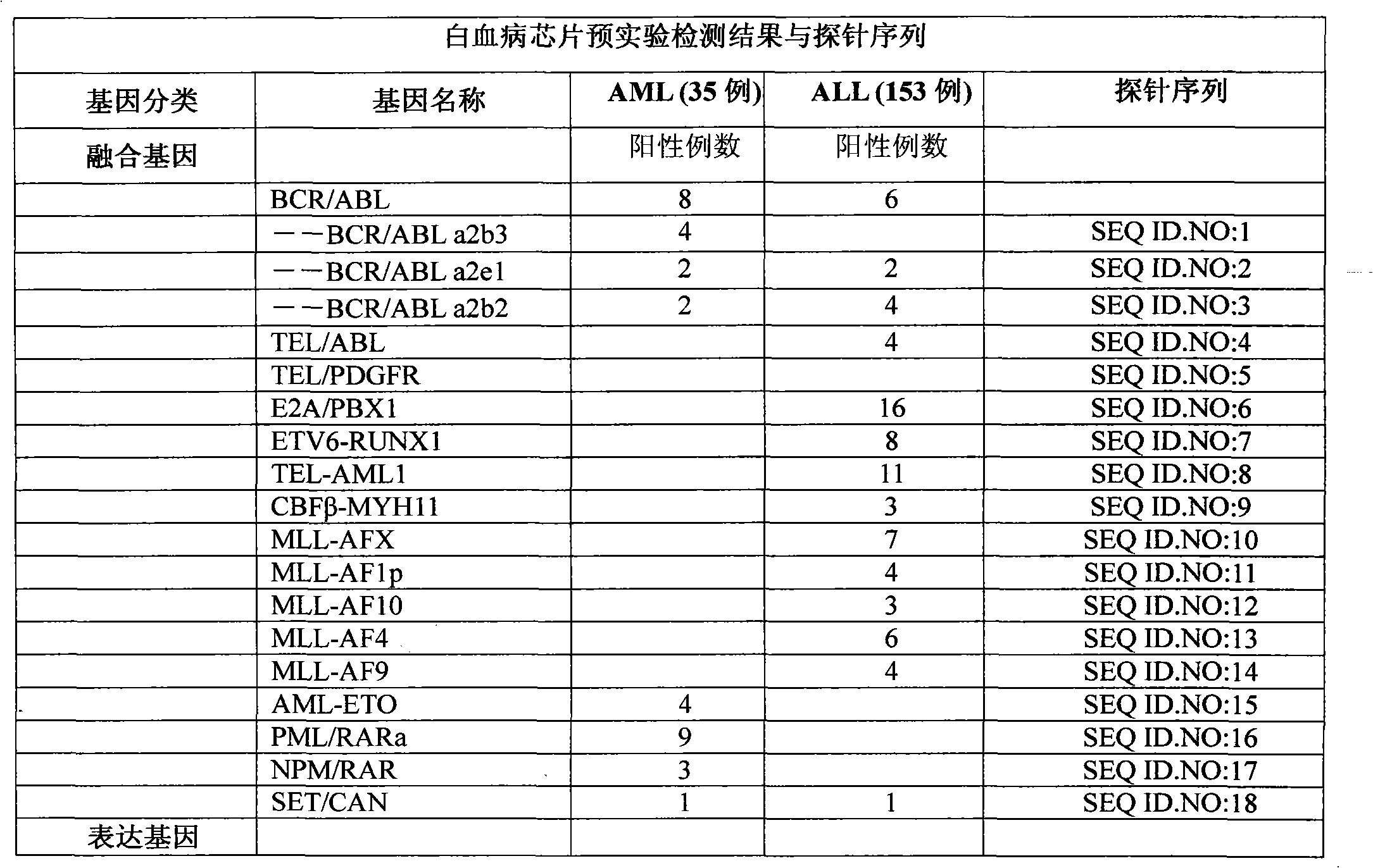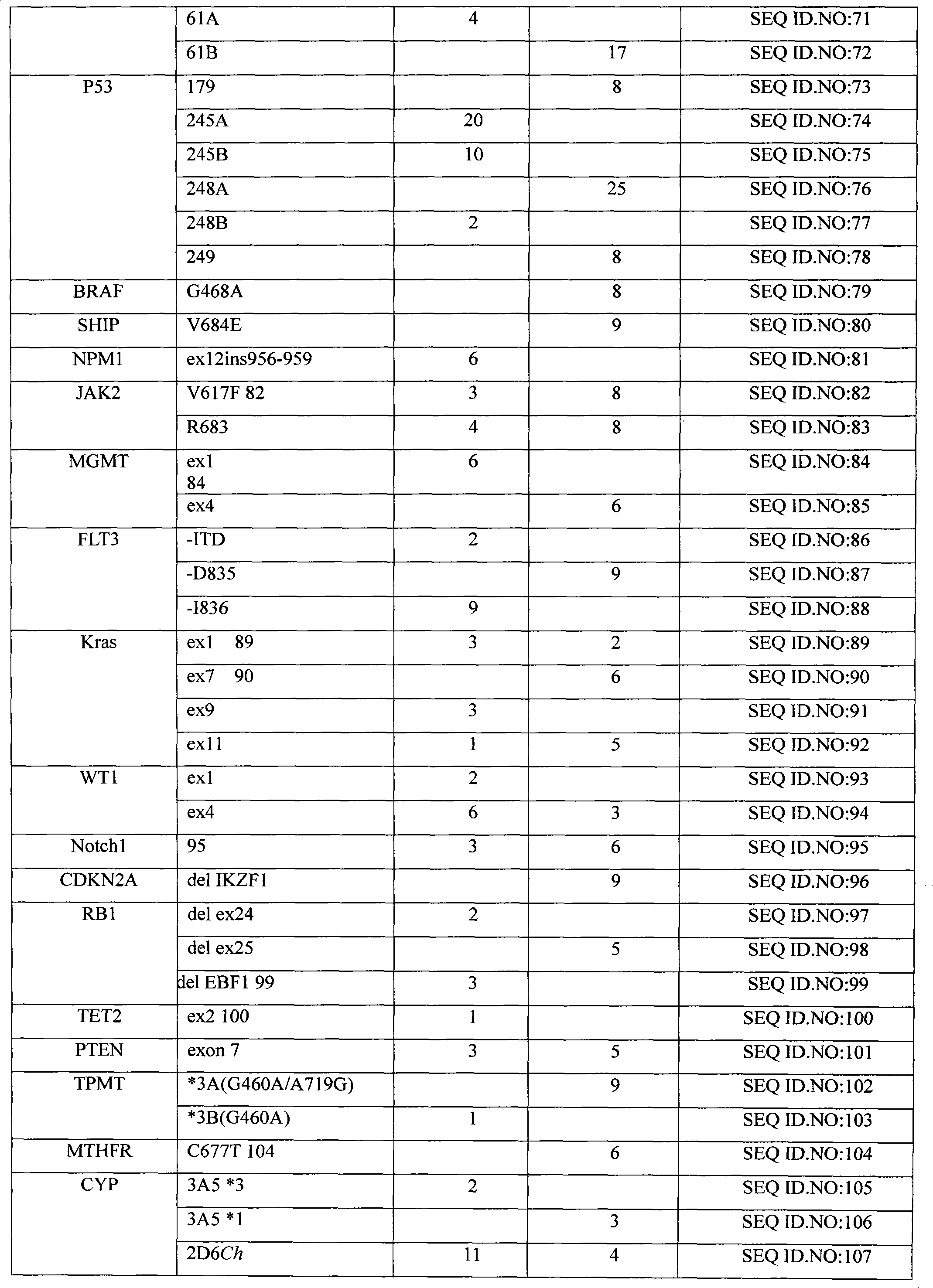Gene chip for leukemia diagnosis and treatment
A gene chip and leukemia technology, applied in the field of molecular medicine, can solve the problems of inability to early diagnosis, risk assessment and individualized treatment of children, low overall control level, and expensive detection costs, so as to shorten hospitalization time, reduce medical expenses, and improve diagnosis. The effect of rate and efficacy
- Summary
- Abstract
- Description
- Claims
- Application Information
AI Technical Summary
Problems solved by technology
Method used
Image
Examples
Embodiment 1
[0023] The preparation of embodiment 1 gene chip
[0024] 1. Probe Design and Synthesis
[0025] The aforementioned chip is mainly divided into a gene expression detection unit and a gene polymorphism (SNP) detection unit, wherein the gene expression detection unit includes 18 fusion gene oligonucleotide probes and 48 expression gene oligonucleotide probes ; SNP unit contains gene SNP 47 kinds of probes.
[0026] The fusion gene oligonucleotide probe of the gene expression detection unit of the kit can specifically detect the fusion gene, which provides an important basis for leukemia diagnosis, typing, clinical treatment and prognosis judgment, and is also the basis for detection of leukemia minimal residual disease. Objects include BCR / ABL a2b3, BCR / ABL a2e1, BCR / ABLa 2b2, TEL / ABL, TEL / PDGFR, E2A / PBX1, ETV6-RUNX1, TEL-AML1, CBFβ-MYH11, MLL-AFX, MLL-AF1p, Any one or more of MLL-AF10, MLL-AF4, MLL-AF9, AML-ETO, PML / RARa, NPM / RAR and SET / CAN.
[0027] The expressed gene olig...
Embodiment 2
[0034] Embodiment 2 Chip performance testing
[0035] 1. Gene chip hybridization
[0036] Hybridization experiments to determine specificity were performed in duplicate, while other microarray hybridization experiments were performed in triplicate. 15 μl of standard hybridization solution contained 3×sodium citrate buffer solution (SSC), 1 μg of unlabeled herring egg DNA (Promega, Madison, USA), 0.3% sodium dodecyl sulfate (SDS) and 5 μl of the target PCR product. The volume of the hybridization solution used for testing the sensitivity and detecting the target gene is 2 μl, and the concentration of the components contained therein is the same as before. The hybridization solution is directly added to the exact position where the fixed DNA array is, and then covered with a cover slip. The fluorescein-labeled DNA was diluted with hybridization solution, denatured at 100°C for 2 minutes, cooled to ambient temperature, first added to the coverslip, and then placed on the covers...
Embodiment 3
[0040] Application of Embodiment 3 Chip
[0041] The detection process of this gene chip is the same as that of other gene chips containing gene oligonucleotide probes.
[0042] 188 cases of leukemia, including 35 cases of acute myeloid leukemia (AML) and 153 cases of acute lymphoblastic leukemia (ALL), were tested, total RNA was extracted, and then the RNA was reverse transcribed into cDNA, and the detection results were analyzed using this chip , see the table below.
[0043]
[0044]
[0045]
[0046]
[0047] Compared with traditional methods of morphology, immunology, cytogenetics and molecular biology, the results are as follows:
[0048]
PUM
 Login to View More
Login to View More Abstract
Description
Claims
Application Information
 Login to View More
Login to View More - R&D
- Intellectual Property
- Life Sciences
- Materials
- Tech Scout
- Unparalleled Data Quality
- Higher Quality Content
- 60% Fewer Hallucinations
Browse by: Latest US Patents, China's latest patents, Technical Efficacy Thesaurus, Application Domain, Technology Topic, Popular Technical Reports.
© 2025 PatSnap. All rights reserved.Legal|Privacy policy|Modern Slavery Act Transparency Statement|Sitemap|About US| Contact US: help@patsnap.com



